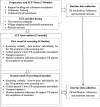Breaking barriers for TB elimination: A novel community-led strategy revolutionizing tuberculosis case finding and treatment support in Senapati District Manipur-A quasi-experimental pre-post study protocol
- PMID: 40608799
- PMCID: PMC12225811
- DOI: 10.1371/journal.pone.0326324
Breaking barriers for TB elimination: A novel community-led strategy revolutionizing tuberculosis case finding and treatment support in Senapati District Manipur-A quasi-experimental pre-post study protocol
Abstract
Introduction: Despite being the world's highest tuberculosis (TB) burden country, India still misses millions of TB cases annually. To address this issue, the India National Strategic Plan, following WHO strategy, promotes combining active case finding (ACF) with passive case finding (PCF) activities. National TB Elimination Programme (NTEP) began ACF campaigns thrice a year, targeting vulnerable populations. However, states like Manipur faced challenges in implementing and sustaining ACF activities due to resource constraints.
Objective: To assess the impact of engaging student and women organizations (SAWOs) in improving TB case notifications, treatment adherence, and completion rate in NTEP, as well as to estimate the cost-effectiveness of the ACF intervention.
Method: A quasi-experimental pre-post study is being conducted among individuals ≥15 years residing in Senapati District, Manipur, having two phases: preparatory and enhanced case finding and implementation of the ACF. Data is being collected and compared on TB case notification, treatment adherence, and outcomes beforeand after the intervention. Chi-square test will be used to test the statistical significance and logistic regression to identify the factors independently associated with the impact of intervention. Potential confounders at both patient and facility levels will be identified based on expert opinion and bivariate analysis. A multi-level logistic regression model will be used to control the confounding, with sensitivity analysis to ensure result robustness.Cost analysis will cover direct, indirect, medical, and non-medical costs for patients and health system. Incremental cost-effectiveness ratio per quality-adjusted life years gained will be evaluated.
Discussion: This study introduces a novel community-led model involving SAWOsto improve TB case detection and treatment support, comprehensively addressing allfour pillars of 'END TB' strategy. The intervention is a community-based participatory research, emphasizing collaboration between researchers andcommunity to address TB control. The main activities of this intervention include community TB sensitization, ECF, ACF, treatment support and monitoring. This model could significantly impact TB control efforts, especially in resource-constrained settings like Manipur, offering valuable insights into ACF implementation and its economic implications.
Copyright: © 2025 A et al. This is an open access article distributed under the terms of the Creative Commons Attribution License, which permits unrestricted use, distribution, and reproduction in any medium, provided the original author and source are credited.
Conflict of interest statement
The authors have declared that no competing interests exist.
Figures


References
-
- WHO. Global Tuberculosis Report 2022 [Internet]. Geneva; 2022. Available from: https://www.who.int/teams/global-tuberculosis-programme/tb-reports/globa...
-
- WHO. Global Tuberculosis Report 2020 [Internet]. Geneva: World Health Organization; 2020. Available from: https://www.who.int/publications/i/item/9789240013131
MeSH terms
LinkOut - more resources
Full Text Sources
Medical

